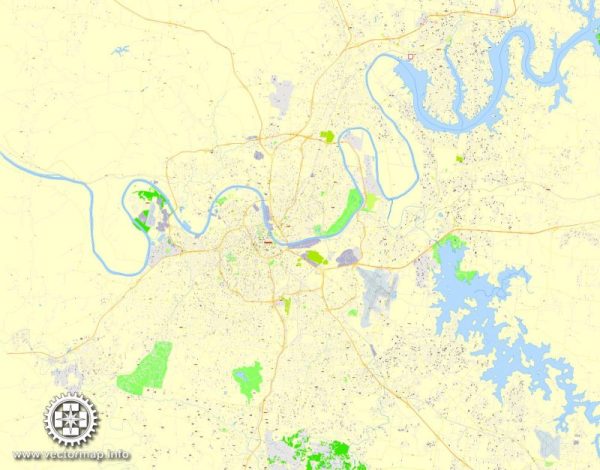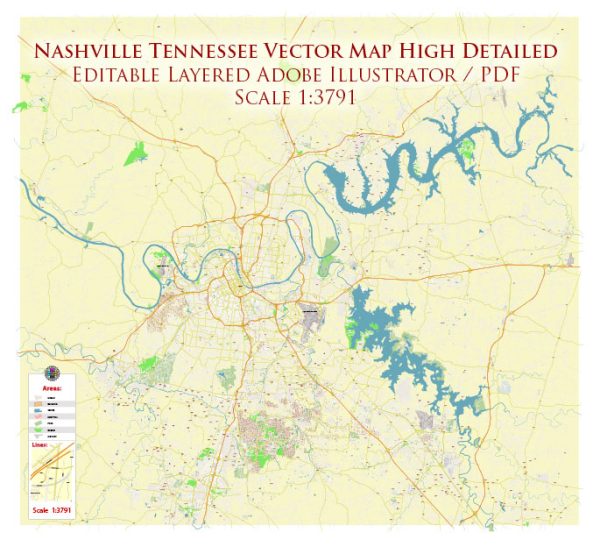Nashville, Tennessee, is a city deeply rooted in history, with a rich tapestry of historic attractions, streets, and squares that reflect its cultural and musical heritage.
Vectormap.Net provide you with the most accurate and up-to-date vector maps in Adobe Illustrator, PDF and other formats, designed for editing and printing. Please read the vector map descriptions carefully.
Here’s a detailed description of some of the most notable historic sites, streets, and squares in Nashville:
Historic Attractions in Nashville
**1. Ryman Auditorium
- Overview: Known as the “Mother Church of Country Music,” the Ryman Auditorium is one of Nashville’s most iconic historic landmarks. Originally built as the Union Gospel Tabernacle in 1892, it became the home of the Grand Ole Opry from 1943 to 1974.
- Significance: The Ryman has hosted legendary performances by some of the biggest names in music, including Johnny Cash, Elvis Presley, and Patsy Cline. It remains a premier concert venue and a must-visit for anyone interested in Nashville’s musical heritage.
**2. The Hermitage
- Overview: The Hermitage is the historic plantation and home of Andrew Jackson, the 7th President of the United States. Located just outside of Nashville, it is one of the largest presidential homes open to the public.
- Significance: The Hermitage offers insights into Jackson’s life and the early 19th-century South. The estate includes the mansion, gardens, slave quarters, and a museum that explores the complex legacy of Andrew Jackson and the era in which he lived.
**3. Belle Meade Plantation
- Overview: Belle Meade Plantation is a historic mansion and former thoroughbred horse farm that played a significant role in the development of the American South. The estate dates back to 1807 and is located in the affluent Belle Meade neighborhood.
- Significance: Visitors to Belle Meade can tour the Greek Revival mansion, the grounds, and outbuildings, including a dairy, carriage house, and slave cabins. The plantation is also known for its role in the history of thoroughbred racing in the United States.
**4. Tennessee State Capitol
- Overview: The Tennessee State Capitol, completed in 1859, is a National Historic Landmark and one of the oldest working state capitols in the United States. It was designed by architect William Strickland, who is also buried within its walls.
- Significance: The Capitol is the seat of Tennessee’s government and a key symbol of the state’s political history. The building and surrounding grounds include statues of notable figures such as President Andrew Jackson and President James K. Polk, whose tomb is also located on the grounds.
**5. Fort Negley
- Overview: Fort Negley is a Civil War-era fortification built by Union forces after they captured Nashville in 1862. It is the largest inland stone fort constructed during the war and played a crucial role in the defense of the city.
- Significance: Today, Fort Negley is a public park and historic site that offers visitors a chance to explore the remnants of the fort, learn about Nashville’s role in the Civil War, and enjoy panoramic views of the city.
**6. The Parthenon
- Overview: Located in Centennial Park, the Parthenon is a full-scale replica of the ancient Greek temple in Athens. It was originally built as part of the Tennessee Centennial Exposition in 1897 and now houses an art museum.
- Significance: The Parthenon reflects Nashville’s nickname, the “Athens of the South,” and is a symbol of the city’s dedication to the arts and education. Inside, visitors can view a large statue of Athena and a collection of American art.
**7. Union Station
- Overview: Union Station, built in 1900, is a former railroad terminal that has been transformed into a luxury hotel. The station’s Romanesque architecture and grand interior spaces make it one of Nashville’s most impressive historic buildings.
- Significance: Union Station played a vital role in Nashville’s development as a transportation hub in the early 20th century. Today, it stands as a reminder of the city’s industrial and transportation history.
Historic Streets and Squares in Nashville
**1. Broadway
- Overview: Broadway is Nashville’s most famous street, running through the heart of downtown. Known for its neon lights, honky-tonk bars, and live music venues, Broadway is the epicenter of Nashville’s vibrant music scene.
- Significance: Broadway is where visitors can experience the essence of Nashville’s country music heritage. The street is lined with historic buildings, many of which house world-renowned music venues like Tootsie’s Orchid Lounge and the Ernest Tubb Record Shop.
**2. Second Avenue
- Overview: Second Avenue, running parallel to the Cumberland River, is one of Nashville’s most historic streets. It is characterized by its late 19th-century Victorian buildings, many of which have been repurposed into restaurants, shops, and bars.
- Significance: This street was historically a hub for trade and commerce, especially for the city’s river traffic. Today, it remains a lively part of the downtown area, offering a mix of entertainment, dining, and shopping.
**3. Printer’s Alley
- Overview: Printer’s Alley is a narrow, historic alleyway in downtown Nashville that was once the center of the city’s printing and publishing industry. During the early 20th century, it became known for its nightlife and speakeasies.
- Significance: Printer’s Alley has retained its reputation as a nightlife destination, with a variety of bars and clubs offering live music and entertainment. The area’s historic charm and unique atmosphere make it a favorite among locals and tourists alike.
**4. Capitol Hill
- Overview: Capitol Hill is the area surrounding the Tennessee State Capitol, located at the top of a hill in downtown Nashville. The streets leading to the Capitol are lined with historic buildings and monuments.
- Significance: Capitol Hill is the political heart of Nashville and Tennessee, with a concentration of government buildings and offices. The area is also home to several historic churches and institutions.
**5. Music Row
- Overview: Music Row is a historic district located southwest of downtown Nashville, home to the heart of the city’s music industry. It includes the offices of record labels, recording studios, and other music-related businesses.
- Significance: Music Row is synonymous with Nashville’s reputation as “Music City, USA.” It’s where countless hit records have been produced, and it remains a key center for the music business.
**6. Public Square
- Overview: Public Square is a historic square in downtown Nashville, located in front of the Metropolitan Courthouse. The square has been a central gathering place in the city since the 18th century.
- Significance: Public Square has undergone several transformations over the years, but it remains an important civic space in Nashville. The square hosts various public events, concerts, and festivals throughout the year.
**7. Germantown
- Overview: Germantown is one of Nashville’s oldest neighborhoods, known for its well-preserved 19th-century architecture and historic charm. The neighborhood is located just north of downtown.
- Significance: Germantown’s historic streets are lined with Victorian homes, and the area has become a popular destination for its restaurants, cafes, and cultural events, including the annual Oktoberfest celebration.
Summary
Nashville’s historic attractions, streets, and squares offer a rich and diverse experience, reflecting the city’s deep cultural roots and vibrant history. From the legendary Ryman Auditorium and the stately Hermitage to the lively Broadway and the historic Printer’s Alley, these sites capture the essence of Nashville’s past and its enduring influence on American culture. Whether you’re exploring the grand architecture of Capitol Hill, the musical heritage of Music Row, or the historic charm of Germantown, Nashville’s historic areas provide a fascinating glimpse into the city’s evolution and its unique place in history.



 Author: Kirill Shrayber, Ph.D.
Author: Kirill Shrayber, Ph.D.